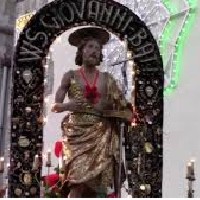Home - In and around
CHURCH OF ST JOHN THE BAPTIST OF CASTANEA MESSINA
Church of St John the Baptist of Chinese of the Furies in the municipality of Messina.
the main church of the village, dedicated to the Patron Saint.
It was built by the city in 1500 and lies under the jurisdiction of the Knights Hospitaller.
Was managed for a long time by the order of the Hospitallers of St John in Jerusalem, for which the garrison in the town of Castanea was a strategic outpost in Peloritani. colpa in 1908 earthquake ¬ region of Messina was partially destroyed.
They remained unharmed some capitals, the transept, the area absidiale side with paintings in the basin, the high altar and the altar of the Blessed Sacrament and Saint John with the precious statue of 1690.
The two chapels still retain the original look. It was rebuilt on the site of the previous Romanesque structures-eclectic and reopened for worship in 1933.
The simple façade is embellished by three portals with stone arches carved with crosses, ornaments and floral motifs. Alongside stands the sturdy, but not very tall, Bell Tower crowned by battlements.
The Interior has a Latin cross with three naves. The ceiling is covered with wooden trussed ceiling. Inside are seeing some marble, decorated with beautiful swirls colourful frontals.
In the Church are also kept a painting and a statue of Saint John the Baptist.
The picture according to legend would be wrecked on the Tyrrhenian coast in the nearby fishing village of Rodia, from where he was then transported to nearby Castanea.
The statue is a work of 1690 made by prof. Antonio Zizza, depicting the Saint, wearing a simple goat skin, as from legend and is carried in procession to the village on the day of the feast of the Saint.
the main church of the village, dedicated to the Patron Saint.
It was built by the city in 1500 and lies under the jurisdiction of the Knights Hospitaller.
Was managed for a long time by the order of the Hospitallers of St John in Jerusalem, for which the garrison in the town of Castanea was a strategic outpost in Peloritani. colpa in 1908 earthquake ¬ region of Messina was partially destroyed.
They remained unharmed some capitals, the transept, the area absidiale side with paintings in the basin, the high altar and the altar of the Blessed Sacrament and Saint John with the precious statue of 1690.
The two chapels still retain the original look. It was rebuilt on the site of the previous Romanesque structures-eclectic and reopened for worship in 1933.
The simple façade is embellished by three portals with stone arches carved with crosses, ornaments and floral motifs. Alongside stands the sturdy, but not very tall, Bell Tower crowned by battlements.
The Interior has a Latin cross with three naves. The ceiling is covered with wooden trussed ceiling. Inside are seeing some marble, decorated with beautiful swirls colourful frontals.
In the Church are also kept a painting and a statue of Saint John the Baptist.
The picture according to legend would be wrecked on the Tyrrhenian coast in the nearby fishing village of Rodia, from where he was then transported to nearby Castanea.
The statue is a work of 1690 made by prof. Antonio Zizza, depicting the Saint, wearing a simple goat skin, as from legend and is carried in procession to the village on the day of the feast of the Saint.



